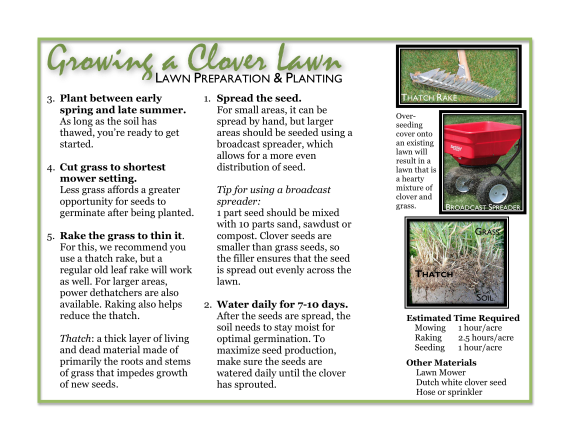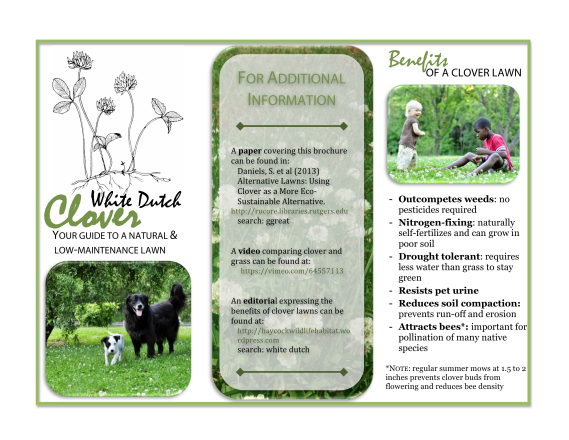Clover lawns are a sustainable alternative over grass lawns. This post goes on to explain the reasons by incorporating two editorials and two brochures. This content was provided by Steven Daniels and Kelsey Noll, both School of Environmental and Biological Sciences students over at Rutgers University. They have proposed the use of clover lawns at their university to save resources, promote bee populations, and raise public awareness of the benefits of clover. For your convenience, there is a table of contents below to organize the information.
Order of Content:
1. Editorial by Kelsey Noll
2. Editorial by Steven Daniels
3. Brochure for Clover at Home
4. Poster Presented to the Rutgers Energy Institute
1. Consider overseeding your Lawn with Clover
by Kelsey Noll
A picturesque green grass lawn is associated with the suburban dream; it is a symbol of status and good citizenship. However, the maintenance of such a lawn is incredibly timely and costly, not to mention completely unnatural and harmful to the environment. The required input of resources to maintain a green lawn, especially throughout the entire year, is quite large. Watering, pesticide and fertilizer application, and mowing all place a significant time and financial burden on the homeowner while polluting the environment through run-off and toxic emissions.
Foregoing the traditional grass lawn in favor of a more sustainable alternative can alleviate these burdens. Clover is an excellent alternative choice for a lawn; though traditionally considered a weed, clover has many properties that make it ideal for lawn coverage. Its ability to outcompete other species means that herbicides need not be applied. It is also nitrogen-fixing, and therefore does not require additional fertilizer application. Clover is drought resistant, meaning it requires minimal watering to stay green. The deep root system of clover helps alleviate soil compaction, a problem that causes run-off and erosion.
The species recommended for a homeowner looking to grow his or her own clover lawn is White Dutch Clover. This species is a perennial plant that grows to four to eight inches in height, with long roots that grow in moist, fertile soil. One of the interesting benefits of growing this breed of clover is that its pollen attracts honey-producing bees. While bees may be considered a nuisance to some, they are an incredibly important species that is currently in danger due to colony collapse disorder. Once can support this at-risk species by maintaining a clover lawn. However, for the homeowner that would prefer to not attract bees, more regular summer mowing will keep them at bay.
Any homeowner should consider planting a clover lawn over their traditional grass lawn. The planting process is easy, as clover can be seeded over an existing lawn to create a durable grass-clover blend that has many advantages over a traditional lawn. The new clover lawn will require significantly less input of time and resources, making life easier for one’s schedule and budget while also serving the environment.
2. Clover lawns beneficial
by Steven Daniels
A well-maintained lawn is part of the American dream. It’s a symbol of the suburban lifestyle, and it shows off the property owner’s control over nature. A green lawn is a constant battle with the environment, but it doesn’t have to be. Clover is a low-maintenance alternative lawn that retains the green lawn aesthetic, without infringing on your wallet or your weekend while benefiting the environment.
Unlike commercial grasses, clover doesn’t require excessive resources. It produces its own fertilizer. Normal grass fertilizers wash away during the first rain shower. Materials purchased for that lawn are essentially being flushed down the drain. Much of that sewer water then ends up in the local water supply, encouraging bacteria to grow and suffocate fish populations. By using clover, you can save money on your lawn while also befriending the local wildlife.
Clover needs very little water to survive. Often referred to as a weed, clover is extremely resilient to seasonal changes. It can survive both flood and drought and stays green while doing it. Clover is like the camel of lawns — effectively holding moisture, but without the whole spitting-on-tourists thing. The plant’s toughness means that it doesn’t have to be watered by property owners to look great. Without a sprinkler, you can save money on water and save our most essential natural resource.
Clover lawns require less frequent mowing than a traditional grass lawn. While grass grows vertically, clover grows laterally. This means you can expect fewer cuts per year and less spotty coverage with clover. Fewer cuts not only reduce budgets spent on gas, bags and repairs, but something even more valuable: time. With that extra time, a homeowner might actually be able to appreciate the lawn they’ve sculpted by playing catch or relaxing in the shade.
Compared to grass, clover is an easy, cost-reducing way to enjoy your lawn. It leaves more money in your pocket, is less of hassle to maintain, and as a nice side benefit, is a more sustainable practice. When we think of sustainability, we tend to think in terms of large complex objects and technology. Businesses and homeowners are offered incentives to install expensive solar panels on their properties, and automobile manufactures offer more hybrid and electric alternatives, for a price. These are steps in the right direction, but truly effective environmental changes will occur more subtly. Much like re-engineered water bottles and cloth grocery bags, alternative lawns represent a small change that can provide substantial gains.
3. Clover at Home Informational Brochure
PDF Attachment: Clover Brochure 

4. Rutgers Energy Institute Poster
PDF Attachment: Rutgers Energy Institute Poster 